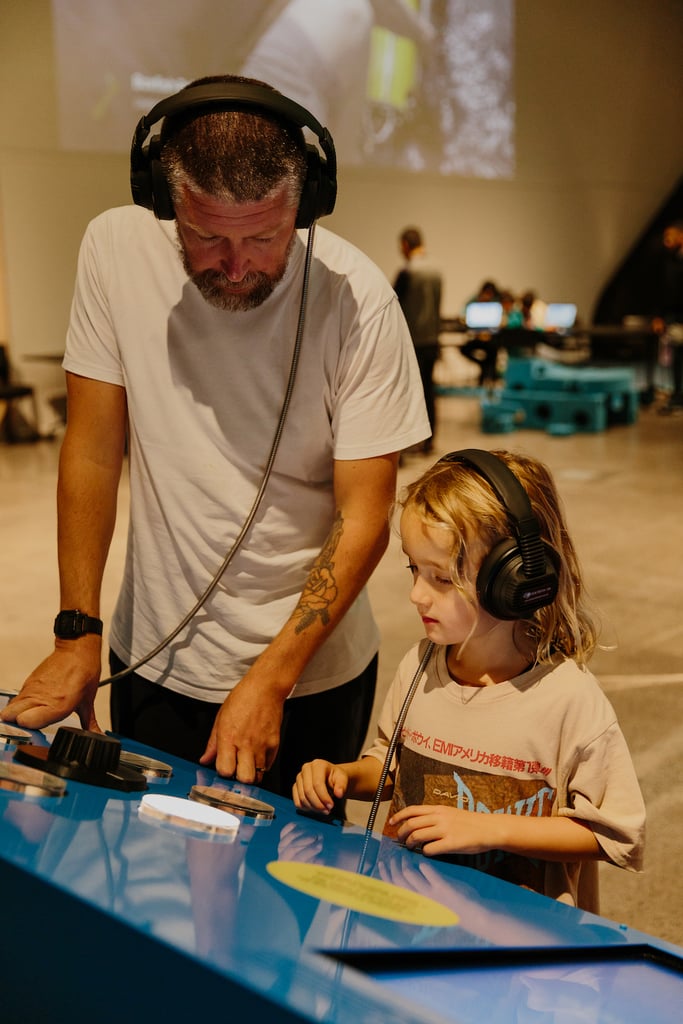
Branded the arty kid at school, exhibition designer Scott Parker has long been aware of the perception that science and arts don’t intersect.
But with his latest project, Te Puawānanga, a science centre at Auckland’s Museum of Transport and Technology, he wants people to know the two are inextricably linked. And as I walk around the centre, that’s exactly what I see: the perfect marriage between those two fields.
During the process of creating Te Puawānanga, exhibition designer Scott Parker consulted regularly with his five-year-old, Marlo.
As we chat over video call, Parker chuckles, describing how useful it was to have Marlo to bounce ideas off.
“I think they do make you look at things from a completely different perspective, both physically as well as from an imagination perspective.”
And when it comes to creativity and imagination, Te Puawānanga is bursting at the seams.
The centre, which opened in May this year, is built into MOTAT’s main exhibition hall. Its name, Te Puawānanga, speaks to the blossoming of knowledge in te reo Māori.
The main area is aptly named Te Puku, for the belly, as it is the central space to soak up the surrounding science.
Three exhibits catch the eye immediately: a chromatic shadow wall, the energy machine and a vertical rainbow.
When I attend with my nieces and nephews, the shadow wall is a big source of fun as we dance in and out of the different coloured lights and make animal shapes with our hands.
On the opposite side of the hall, the energy machine is a sprawling mass of orange, long limbs extending from its centre, like an octopus. It gets fed by people who provide it with energy, which it then releases on the half hour in a fanfare of noise.
“[It] was a conscious decision to encourage eight individuals, whether they know each or not to contribute to a single thing,” says Parker.
“Those relationships in spaces like that are really important and you see how rewarding they are for people… Everyone can go into a space like that and enjoy the same thing without any barrier in between.”
The vertical rainbow is Parker’s favourite, for the way it incorporates the story of legendary Polynesian explorer Kupe and it presents light and the way it reacts in an art gallery-style installation.
Read more: MOTAT’s immersive project wins global award
“[It] was something that took quite a lot of convincing and so I’m stoked that I had the backing of the team to trust me that’ll it be good,” Parker laughs.
One of my favourite parts is the large, light-up periodic table, where each element square contains an example of where it’s used in everyday life, as well as the mirror room, where a collection of patterned poles reflects Auckland’s multicultural community.
Other exhibits explain complex physics concepts like light reflection and refraction, X-Rays and the power behind simple machines and pulley systems.

As I walk around I ponder how science becomes so much more enjoyable when it’s displayed like this, in a format that everyone can understand and interact with.
Parker agrees, saying displaying STEM principles and concepts in an artistic way is hugely important to him.
“If you can present scientific outcomes in a beautiful, hands-on way, you can spark a little bit of that interest from both sides of that coin.”
A slide leads visitors down to Te Waha, the heart, a multi-use innovation space where people can take on some self-led design challenges, get a brief run down on the history of audio as well as interact with a large projected light display.
Back upstairs, Te Tumu, the foundation, holds a play space for children aged five and under, separated from the rest by safety gates.
It deviates from a typical play space – instead of bright and jarring, it’s soft, and warm. There’s plenty of discovery moments at a child’s eye level, a large tree made of Autex taking centre stage, and toy kumara and eels (crocheted by a MOTAT staff member) litter the floor.
Furthermore, there’s no primary colours, says Parker.
“… We wanted to use natural timbers and products and finishes that make you feel welcome, because at the end of the day, it’s for children but also for their caregivers.”
Creating spaces where everyone, from school groups to a toddler and parent, to an individual, feels welcome was a key part of the design process, Parker adds.
“There was a lot of work around the stories we wanted to tell before even getting into the design work… and how to get visitors from A to B and the options that they have.”
He gives a nod to MOTAT’s Design Manager and Graphic Designer, Jessica Gommers, who he’s worked with on other projects for the last decade.
“That relationshop was really strong from the start. She’s got a really good knowledge of how and where that building sits in terms of Tāmaki, but also within MOTAT.”
As for the final verdicts from Marlo and his younger daughter, Aubrey, they love Te Puawānanga, says Parker.
Flying up to Auckland with his family from their Hawke’s Bay home was a special moment for Parker, who says his kids were stoked to be playing with others in Te Tumu.
“It was funny watching them with the crocheted eels and making a fire pit and pretending that they were cooking… It was pretty cool.”


